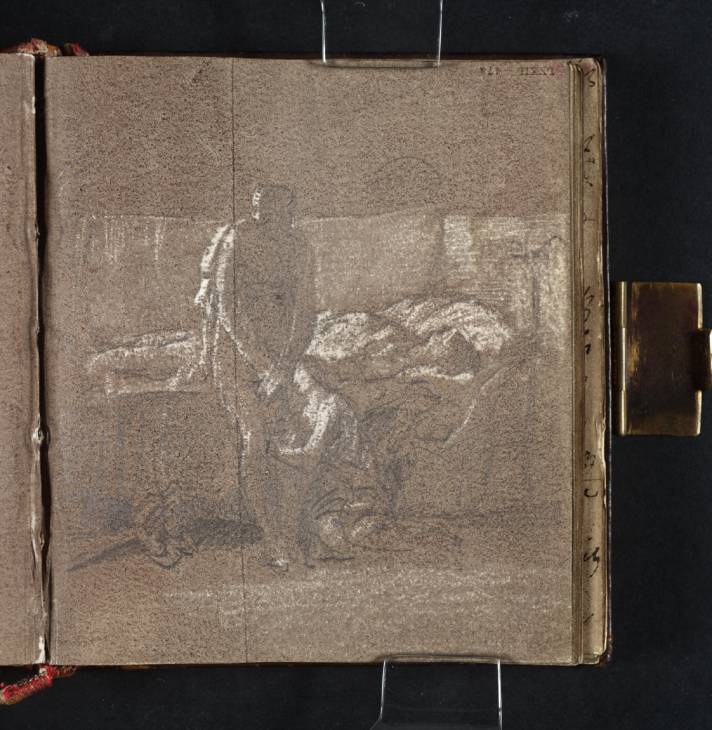Joseph Mallord William Turner The Return of Marcus Sextus, after Pierre-Narcisse Guérin 1802
Joseph Mallord William Turner,
The Return of Marcus Sextus, after Pierre-Narcisse Guérin
1802
Joseph Mallord William Turner 1775–1851
Folio 47 Verso:
The Return of Marcus Sextus, after Pierre-Narcisse Guérin 1802
D04334
Turner Bequest LXXII 47a
Turner Bequest LXXII 47a
Pencil, with some scratching out, on white wove paper prepared with a dark reddish brown wash, 128 x 114 mm
Inscribed by John Ruskin in red ink ‘47’ top left (inverted)
Stamped in black ‘LXXII–47’ top left (inverted)
Inscribed by John Ruskin in red ink ‘47’ top left (inverted)
Stamped in black ‘LXXII–47’ top left (inverted)
Accepted by the nation as part of the Turner Bequest 1856
Exhibition history
1999
Turner on the Seine, Tate Gallery, London, June-October 1999, Pavillon des Arts, Paris, October 1999–January 2000, Musée Malraux, Le Havre, March–June 2000 (2).
References
1909
A.J. Finberg, A Complete Inventory of the Drawings of the Turner Bequest, London 1909, vol.I, p.189, LXXII 47a.
1961
Alexander J. Finberg, The Life of J.M.W. Turner, R.A. Second Edition, Revised, with a Supplement, by Hilda F. Finberg, revised ed., Oxford 1961, p.91.
1974
Gerald Wilkinson, The Sketchbooks of Turner, R.A., 1802–20: Genius of the Romantic, London 1974, p.56.
1979
Andrew Wilton, J.M.W. Turner: His Life and Work, Fribourg 1979, pp.74, 79, reproduced pl.69.
1985
Jack Lindsay, Turner: The Man and His Art, London 1985, p.38.
1987
Andrew Wilton, Turner in his Time, London 1987, p.64, reproduced pl.87.
1990
David Blayney Brown, The Art of J.M.W. Turner, London 1990, p.59 reproduced.
1993
Jean-Pierre Cuzin and Marie-Anne Dupuy, Copier créer. De Turner à Picasso: 300 oeuvres inspirées par les maîtres du Louvre, exhibition catalogue, Musée du Louvre, Paris 1993, p.80.
1993
Josette Bottineau, ‘De Bélisaire à Marcus Sextus: Génése et Histoire d’un Tableau de Pierre Guérin (1774–1833)’, Révue du Louvre, 3, 1993, p.50.
1997
Anthony Bailey, Standing in the Sun: A Life of J.M.W. Turner, London 1997, pp.69–70.
1999
Ian Warrell, Turner on the Seine, exhibition catalogue, Tate Gallery, London 1999, pp.17 reproduced fig.3, 18, 265.
2009
Guillaume Faroult and David Solkin, in David Solkin ed., Turner and the Masters, exhibition catalogue, Tate Britain, London 2009, pp.88, 89 reproduced in colour fig.46.
Guérin’s (Pierre-Narcisse, Baron Guérin 1774–1833) picture, correctly identified by Finberg, was first shown in the Paris Salon of 1799. It met with great acclaim, inspiring poetic and literary tributes and the painter’s colleagues to decorate its frame with garlands. In its original form it had depicted the blind Belisarius returning home to find his wife dead and his daughter in mourning, but as Jacques-Louis David and François Gerard had recently painted this subject, Guérin restored his hero’s sight and turned him into an imaginary victim of civil war in ancient Rome, banished into exile by Lucius Cornelius Sulla. The new theme had a topical resonance for émigrés forced to flee the recent Terror (1793–4) or now venturing back to France under the Consulate. As his inscription indicates, Turner did not draw the picture in the Louvre (nor in the artist’s studio as stated by Faroult and Solkin), but at the Place des Victoires where its then owner, the cloth manufacturer Jean-Baptiste Decretôt, had his showrooms and residence (nos.2, 8 and 12). Decretôt bought the picture from Guérin in February 1800 and sold it to Lucien Bonaparte in May 1803. The early history of the picture, prior to its acquisition for the French national collections in 1830, is told in detail by Josette Bottineau.1
Turner’s drawing (made with the sketchbook inverted) is treated as an exercise in chiaroscuro, little if any surface colour having been added to the graphite but the grey wash preparation being presumably moistened, and highlights raised by scratching out. It conflates Guérin’s composition, reducing the subject to portrait format and omitting the brazier behind the couch. Joseph Farington’s diary provides the clue to its date. Aware that the picture had been ‘crowned by the French Artists’, Farington reported an afternoon visit to see it and to meet Guérin on 1 October, specifically with the painters Henry Fuseli and Martin Archer Shee. He does not mention Turner by name but his added ‘&c’ must refer to him as Turner had been part of the same company on visits to the Louvre and to other French artists during the morning. Farington’s view was that the work ‘had more of the requisites to form a good picture than any I had seen by a Modern French Artist...There was too much of the French in it; but there was form and light & Shade...We readily agree that it merits distinction, but it seems remarkable that the French should give a preference to that which deviated most from their manner’.2 However, Farington also noted that praise for Guérin was not unanimous, and although the Marcus Sextus was the only modern work Turner copied in Paris, Farington reported that Marguerite Gerard was the one artist he excepted from his general contempt for the current French school; ‘he held it very low, – all made up of Art’.3
David Blayney Brown
July 2005
How to cite
David Blayney Brown, ‘The Return of Marcus Sextus, after Pierre-Narcisse Guérin 1802 by Joseph Mallord William Turner’, catalogue entry, July 2005, in David Blayney Brown (ed.), J.M.W. Turner: Sketchbooks, Drawings and Watercolours, Tate Research Publication, December 2012, https://www

